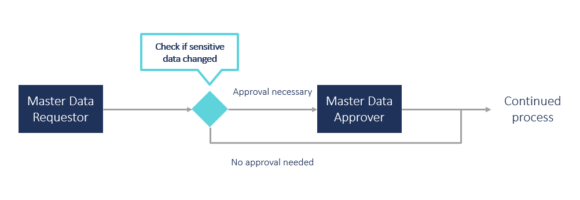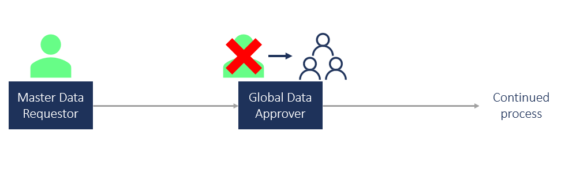Within SAP Master Data Governance (MDG), it is rather simple to set up a master data maintenance process since SAP provides an easy to configure workflow template. Read in this article how we took the existing concepts a step further by providing multiple generic and reusable frameworks that can make the design, implementation and maintenance of your master data processes even better.
The design of a master data maintenance and approval process lays the foundation to ensure that the quality of master data is kept throughout its lifecycle. Each company is different, and so are the processes for maintaining master data. However, some concepts during the maintenance of master data can be abstracted for companies in all industries. These include:
- involving contributors and approvers only if sensitive data was changed,
- automatically route workflows based on the maintained object data (e.g., material data of Business Partner data),
- finding the right persons to contribute to and approve master data,
- enforcing a four-eyes-rule for critical master data changes.
These general concepts have been combined in an easy-to-use solution, the Camelot Plug-and-Play Workflow framework. Within this framework we provide the generic functionalities mentioned above in an easily deployed solution. Hence, a workflow functionality can be implemented. It ensures that future extension and maintenance can be done efficiently by providing a highly customizable solution that can be adapted to a company’s needs.
Let us a closer look into the core components and functionalities included.
Involve Contributors and Approvers only if Sensitive Data Was Changed
The typical target of a SAP MDG implementation is to reduce the amount of available change request types (and therefore workflows). This makes it easier for a user to choose the correct process type which reduces the impact of change management and the user training needed. This however makes it necessary to include all the logic in a smaller number of change request workflows.
One of these logics is the dedicated approval of sensitive data changes, e.g., the address or bank details of a Business Partner. With this concept, you can define this logic in a configuration table and link a step in the workflow to master data changes, which in effect includes these contributors and approvers only when really needed.
Automatically Route Workflows based on the Maintained Data
Following the same logic as described in the section above, many steps during the creation or change of master data can be automated. As such it is possible to combine multiple scenarios regarding the change and approval of data in one overarching maintenance process. A simple example is that a material of the type “Final Product” may need additional manual enrichment steps, while a “Raw Material” follows a leaner process. The same goes for business partners, where “Bill-to” partners may need less of an enrichment process than a “3rd party” that needs more details for the upcoming business interactions.
By checking the maintained data in the workflow itself, we can automatically route the workflow in the appropriate direction. This reduces the number of change request types necessary that would have otherwise been created to cater for the different requirements of the various data types.
In the framework this functionality is fully customizable and can be configured to check any kind of data that has an impact on the workflow routing.
Finding the Right Persons to Contribute to and Approve Master Data
The so-called Workflow Receiver Determination ensures that the correct persons are involved in the process for contribution and/or approval. We provide a generic concept that lets you easily configure allowed receivers for a task in the workflow with a configuration table. The solution is easily extendable to your needs to drill down further with more specific determination criteria, e.g., dedicated approvers for a plant or sales organization.
Enforcing a Four-Eyes-Rule for Critical Master Data Changes
Some master data changes are more critical than others, just think of changes to the bank details of a supplier. With our concept of enforcing a four-eye-principle, we ensure that the person who did the master data change is not allowed to approve the same.
All these functionalities are available out-of-the-box as part of our Camelot Plug-and-Play Workflow framework and are easily integrated into the standard extensibility framework of SAP MDG. They help companies to easily design master data maintenance and approval processes to ensure master data quality. Each company is different, and so are the processes for maintaining master data.
The solution is available as part of our regular SAP MDG consulting and will help improve the setup of the system as well as can be used to improve any existing processes.




